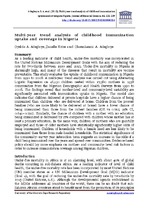Multi-year trend analysis of childhood immunization uptake and coverage in Nigeria
Date
2013Author
Adegboye, Oyelola A.
Kotze, Danelle
Adegboye, Olasunkanmi A.
Metadata
Show full item recordAbstract
As a leading indicator of child health, under-five mortality was incorporated in the United Nations Millennium Development Goals with the aim of reducing the rate by two-thirds between 1990 and 2015. Under-five mortality in Nigeria is alarmingly high, and many of the diseases that result in mortality are vaccine preventable. This study evaluates the uptake of childhood immunization in Nigeria from 1990 to 2008. A multi-year trend analysis was carried out using Alternating Logistic Regression on 46,130 children nested within 17,380 mothers in 1938 communities from the Nigerian Demographic and Health Surveys from 1990 to 2008. The findings reveal that mother-level and community-level variability are significantly associated with immunization uptake in Nigeria. The model also indicates that children delivered at private hospitals have a higher chance of being immunized than children who are delivered at home. Children from the poorest families (who are more likely to be delivered at home) have a lower chance of being immunized than those from the richest families (OR = 0.712; 95% CI, 0.641–0.792). Similarly, the chance of children with a mother with no education being immunized is decreased by 17% compared with children whose mother has at least a primary education. In the same way, children of mothers who are gainfully employed and those of older mothers have statistically significantly higher odds of being immunized. Children of households with a female head are less likely to be immunized than those from male-headed households. The statistical significance of the community–survey year interaction term suggests an increase in the odds of a child being immunized over the years and spread over communities. Evidence-based policy should lay more emphasis on mother- and community- level risk factors in order to increase immunization coverage among Nigerian children.

